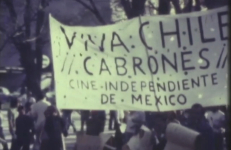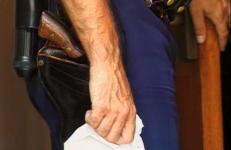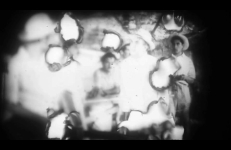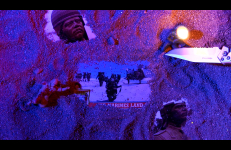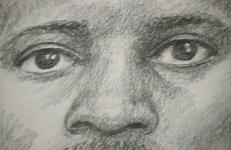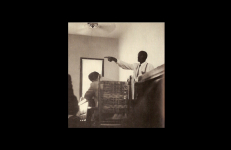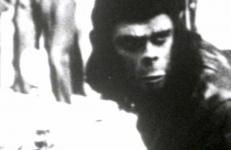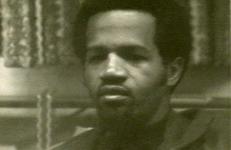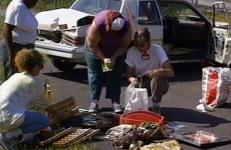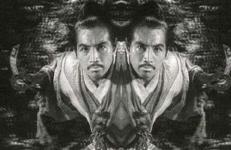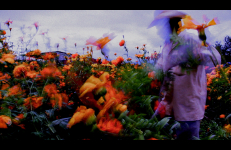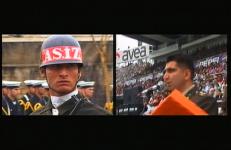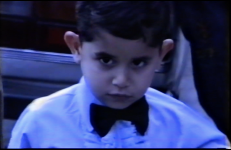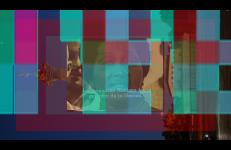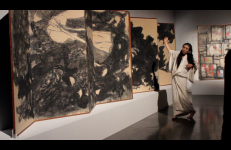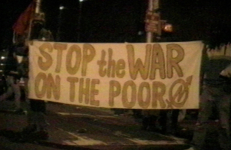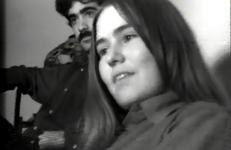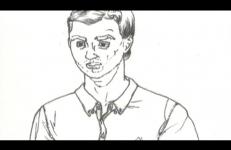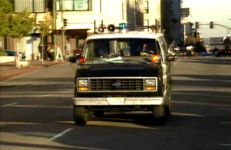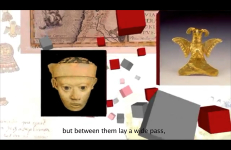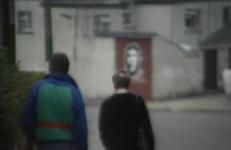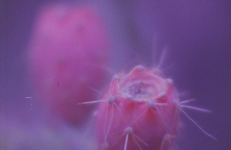This is an audiovisual manifesto in support of people in resistance against a military coup.
Crime or Violence
19 out of the 41 shots fired in 10-seconds by four members of the NYPD Street Crimes Unit hit the defenseless body of one Amadou Diallo as he stood in the vestibule of the building where he lived in the Bronx. This video essay seizes on the grotesquely bald, factual precision of this numerical data, proceeding remorselessly on up from number 1 to 41, rubber-banding 10-seconds into fourteen minutes, and then snapping it tight, in an intense, formal contemplation of how police violence is produced and then addressed by other forces on the city streets.
19 out of the 41 shots fired in 10-seconds by four members of the NYPD Street Crimes Unit hit the defenseless body of one Amadou Diallo as he stood in the vestibule of the building where he lived in the Bronx. This video essay seizes on the grotesquely bald, factual precision of this numerical data, proceeding remorselessly on up from number 1 to 41, rubber-banding 10-seconds into fourteen minutes, and then snapping it tight, in an intense, formal contemplation of how police violence is produced and then addressed by other forces on the city streets.
Through collage, Alazeef shows the dreams and the fears of a typical Iraqi soldier, a week before the 1991 Desert Storm, compared to the huge war machine. Through poetic narration, Alazeef humanizes the "enemy" and separates the people and soldiers on both sides from political agendas. The control of the mise-en-scene gives the film a radiant surreal feeling.
And They Came Riding Into Town on Black and Silver Horses looks at how media representations shape our perception of violence and violent crime, in effect creating racist stereotypes. Andrews suggests that the evidence against young Black men is gathered not at the scene of the crime, but at the scene of representation.
Animated Contingencies is an animated documentary that looks at how sketches take the place of photography in courtroom settings. Andrews focuses on how two different representations, a photograph and a courtroom sketch, capture the moment Moses Wright, Emmett Till's uncle, pointed out Till's murders while on the witness stand at their trial. The work then examines the authority of photographic evidence and how animated representations can provide both visibility and anonymity in testimony and other contexts.
Employing footage from an obscure 8mm film trailer for Battle for the Planet of the Apes to highlight the unstable relationship between the real, historical past and the distant, imaginary future, this project revolves around a central question: Is alien-ness indeed the metaphor for the 20th Century as power relationships have been embodied within our subconscious? Is there a relationship between these forgotten formats and the discontinued political ideologies that they depict?
Portable Channel, a community documentary group in Rochester, New York, was one of the first small format video centers to have an ongoing relationship with a PBS affiliate (WXXI). Portapakers interviewed Sinclair Scott, a member of the negotiating team that went into Attica when the prisoners' rebelled at the federal prison in September 1971. Thirty-eight guards were taken hostage after prisoners' demands to improve their conditions were ignored. After a three day stand-off between inmates and authorities, Governor Nelson Rockefeller called in the National Guard.
This project on family violence, spanned two years and several sites across the country, and involved wrecked cars in sculptural installations. The cars were reconfigured by women and children who suffered violence at the hands of loved ones. Linked to each other through common experience, women from a domestic violence shelter in Pittsburgh, a family violence program at Bedford Hills prison, children from shelters in Niagara Falls and Cleveland, teenage girls in Oakland, and politicians on Staten Island all collaborated in making the cars.
In Bataille, fragments from the Akira Kurosawa’s film Rashomon are subject to a mirror effect. A scene in which two samurai fight each other becomes a cosmic field of monsters where horror and pain evoke beauty and joy.
After the ominous attack that the paramilitary and police corporations carried out on September 26, 2014, in Iguala, Guerrero, the student Aldo Gutiérrez Solano remains in a coma until today. A brief homage to the resistance of the body fighting against power.
"I, Soldier is the first part of a video series in which I am dealing with the state-controlled ceremonies for the national days of the Turkish Republic. The nationalistic attributes attached to these large-scale ceremonies are underlined in a non-descriptive and almost voyeuristic point of view. I, Soldier was shot at the National Day for Youth and Sports; the day that marks the start of the independence war of the Turkish public under the leadership of Mustafa Kemal Atatürk, against the Allied Forces back in 1919.
Bezuna explores the complexities of fleeing a war-zone through the analysis of peripheral details. Through interweaving different narratives, the film presents the raw and broken feelings of a child and a cat whose lives will never be the same.
Black Code / Code Noir unites temporally and geographically disparate elements into a critical reflection on two recent events: the murder of Michael Brown and that of Kajieme Powell by American police officers in 2014. Archaeologically, the film argues that behind this current situation is a sedimented history of slavery, preserved by the Black Code laws of the colonies in the early Americas. These codes have transformed into the algorithms that configure police Big Data and the necropolitical control of African-Americans today. Yet how can we read this in the present?
For the November 13, 2015 opening of the Hiroshima Panels by Iri and Toshi Maruki at Pioneer Works, Eiko performed her solo in honor of the Hiroshima Panels and their creators. Japanese-style painter Iri Maruki, born in Hiroshima, and Western-style painter Toshi Maruki, who went into Hiroshima city just three days after the bombing. The artists decided to paint the panels together, which illuminate the human experiences of the Atomic Bomb. They spent 30 years painting the fifteen Hiroshima Panels, six of which were on display at Pioneer Works in Red Hook, Brooklyn.
A bruise on her face. The woman has white makeup, bright red lips and dark-rimmed eyes, which are largely covered by her hair. Without uttering a word, she hits her face, head and upper body.
Spanning two years of protest and resistance, this video chronicles the politically-motivated police harassment of the homeless population in Manhattan’s Lower East Side; including suspected arson, illegal eviction, and the demolition of buildings that forced families onto the street. Taking its title from a quote by Malcolm X, By Any Means Necessary is an indictment of government systems that violate the law willfully and at random in the service of wealthy real estate developers.
An interview with a group of people shot in October 1969, some of whom were involved in The Weathermen’s "Days of Rage" actions. As those present recount the significance of the actions, and the possible ramifications on the movement as a whole, some critics voice serious complaints.
The Chocolate Factory is a suite of monologues in the voice of a fictionalized serial killer, one monologue for each victim. The camera, with an almost structuralist rigor, pans up and down simple line drawings of each of the seventeen victims. A Black Sabbath song, picked apart and extended, serves as punctuation and soundtrack. Reinke has described the video as, "My autobiography as Jeffrey Dahmer." But really, as the narrator says, "It's all about the victims."
From the performance by the same name, by Suzanne Lacy, Julio Morales and Unique Holland, with Kim Batiste, Raul Cabra, Patrick Toebe, David Goldberg, and Anne Maria Hardeman, Oakland, 1998-2000.
Here, a double morphology of conversion forces us to think about the trance of non-reconciliation, outburst and trance that go through the centuries of colonial violence until reaching us in the tension of an audiovisual disjunction: visible and enunciable. On the one hand the museum, habitat of barbarism, on the other hand the voice, place and body of the furious testimonial. Religious conversion that conveys communal violence. Archaeological conversion that imposes object immobility.
This video takes its departure from the BBC's coverage of the killing of three IRA volunteers by British Security Forces in Strabane, a small town on the border between Northern Ireland and the Irish Republic. Interrogating television discourse, the video examines what is referred to as the British “shoot to kill” policy of planned assassination in the North.
This video takes its departure from the BBC's coverage of the killing of three IRA volunteers by British Security Forces in Strabane, a small town on the border between Northern Ireland and the Irish Republic. Interrogating television discourse, the video examines what is referred to as the British “shoot to kill” policy of planned assassination in the North.
Coyolxauhqui recasts the mythical dismemberment of the Aztec Moon goddess Coyolxauhqui by her brother Huitzilopochtli, the deity of war, the Sun and human sacrifice. The film is a poem of perception, one that unveils how contemporary Mexican femicide is linked to a patriarchal history with roots in deeper cultural constructs.




